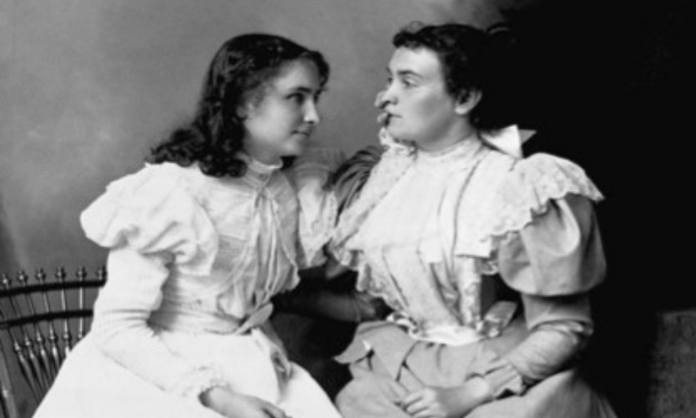By Martin Gleeson
Anne Sullivan’s parents were immigrants from Ireland who settled in Feeding Hills, Massachusetts in the USA. Anne’s mother had come from Castlefarm, Herbertstown, Co. Limerick and suffered from tuberculosis. Anne’s father was an alcoholic, but he passed on his Irish traditions and folklore to his children.
Anne was the oldest of three children and was born in 1866. She had a sister and brother. When she was five years old, she contacted trachoma, a bacterial eye disease. This caused many painful eye infections and gradually made her nearly blind. When Anne was eight years old, her mother died of TB and two years later her father abandoned the three children. Anne and her brother Jimmie were sent to a delapidated almshouse in Tewksbury while Ann’s young sister was handed over to an aunt. After a few months, Jimmie died of TB. Anne stayed on in the alms house and endured two unsuccessful eye operations.
When Anne was almost 11 years old, she was sent to the Soeurs de la Charité, in Lowell, Massachusetts. After a few months Anne was then sent to the city infirmary and later back to the Tewksbury almshouse, very much against her will. When an inspector visited the house, Anne jumped in front of him and shouted: “I want to go to school.”
Finally, after much pleading, Anne was sent to the Perkins School for the Blind in 1880 at the age of 14. This had a positive impact on her life.
Anne began her studies in the Perkins School for the Blind in October 1800, aged 14.
She learned the manual alphabet from Laura Bridgman, the first blind/deaf person to be educated there. Thus, Anne could form letters with her fingers to spell out words into the palm of another person’s hand. Anne’s vision was improved by a number of operations and in 1886 at the age of 20 Anne graduated as top of her class.
In her valedictorian speech she said: “Fellow-graduates: Duty bids us go forth into active life. Let us go cheerfully, hopefully, and earnestly, and set ourselves to find our especial part. When we have found it, willingly and faithfully perform it; for every obstacle we overcome, every success we achieve tends to bring man closer to God and make life more as He would have it.”
After her graduation from the Perkins School for the Blind, Anne was requested to become the teacher for a seven-year-old blind and deaf girl from Alabama called Helen Keller. Helen had lost both her sight and hearing after an illness at the age of 19 months. She lived with her parents in West Tuscumbia, Alabama and initially communicated using signs.
When Anne arrived, she began teaching Helen normal language, including reading and writing. But Helen did not realise that the words represented a range of things. On one momentous day, Anne taught Helen the word “water.” She finally got Helen to understand that the word had a specific meaning by holding her hand under the spout of the water pump. Anne untiringly spelt words on Helen’s hand. Helen learned how to understand and speak other people’s speech by using the Tadoma method. This system showed Helen how to place her little finger on the speaker’s lips and her three other fingers on the speaker’s jawline and thus understand what was being said.
Anne spent 10 years educating Helen. After an education in both specialist and mainstream schools, Helen enrolled in Radcliffe College of Harvard University and was the first deafblind person to obtain a Bachelor of Arts Degree. She later became a prolific writer and campaigner for the rights of people with disabilities. Anne Sullivan made history by being the first person to teach a child that was both deaf and blind. Anne remained Helen Keller’s instructor, interpreter, and personal friend for the rest of her life.
Anne had been seriously visually impaired for most of her life, but after suffering a stroke in 1901, she became totally blind in both eyes. In 1905 Anne married Harvard University instructor John Macy. At that time Anne was living with and teaching Helen Keller, so John Macy moved into the household of the two women. However, this marriage was not a happy one and they separated in 1914. Nevertheless, Anne always called herself Anne Macy Sullivan.
Struggling to gain an income Anne travelled with Helen Keller on lecture tours. On stage she repeated Helen’s words to the audience as Helen was never able to speak clearly. In 1930, accompanied by a few friends, Anne and Helen Keller travelled to Ireland. Anne tried unsuccessfully to trace her roots in Limerick.
In October 1936, the great teacher Anne Sullivan suffered a coronary thrombosis, fell into a coma, and died five days later.
When Anne was introduced to the great writer Mark Twain, he was so impressed that he called her a “Miracle Worker. The drama of Anne Sullivan and Helen Keller’s life has been portrayed in several TV, film and stage productions.
Anne was the main character in a 1957 television drama called The Miracle Worker.
This drama moved to Broadway and was later produced as a feature film. Anne Bancroft played the part of Anne Sullivan on the stage in Broadway and also in the film.
Another great legacy of Anne is the “Anne Sullivan Foundation”, which was established in 1989 in Stillorgan, Co. Dublin to help deafblind children and their families.








